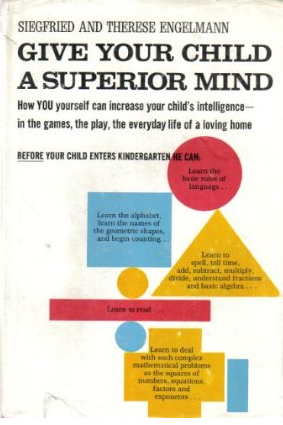
Prologue
Give Your Child a
Superior Mind
Abridged

In 1966, I lived in two worlds. One was inhabited by at-risk children of poverty. The other was that of the middle-class preschooler. I co-authored two books that were published in 1966 and that symbolized these two distant worlds. One was Teaching Disadvantaged Children in the Preschool; the other, Give Your Child a Superior Mind. Each world was pulling me in a different direction.
Give Your Child a Superior Mind was very popular. It didn’t make the best-seller list because a large percentage of its sales were through the Simon and Schuster Book Club. (Only bookstore sales were counted back then.) In terms of copies sold, however, it would have rated in the top five books for many months. I appeared on several nationally broadcast TV shows, like the Merv Griffin Show, and I received a lot of invitations to speak. The prospects were very alluring.
What made them even more attractive was the fact that middle-class preschoolers were so easy to teach and could be accelerated dramatically. It was clear that with good instruction, any average preschooler could be transformed into a gifted individual. By 1966, we had done a fair amount of work with middle-class kids. We had some in the Bereiter-Engelmann preschool. We also worked with another group for three years, as 4-year-olds through 6-year-olds. These kids were flat unbelievable. They were working in material written for fourth graders before they were six years old. They could learn just about anything you wanted to teach and learn it about as fast as you could teach it. Their average IQ was around 155.
A final incentive for pursuing the middle class rather than the disadvantaged children was that middle-class parents were interested in having gifted kids, and, as a group, they had clout. So it seemed that there was definitely a rainbow or a pot of gold at the end of the road that stretched in this direction.
The other direction of the road led to slums, Indian reservations, and poor rural communities. What possible pull did these places have? Why bury oneself in a ghetto school with teachers who needed lots of training and kids who were not easy to teach and who often had very little parental support?
The two books published in 1966 underscored the unattractiveness of this direction. Unlike Give Your Child a Superior Mind, Teaching Disadvantaged Children in the Preschool was reviled, damned, and pretty universally condemned. Carl Bereiter and I were labeled Nazis, kid haters, and people so stupid that we did not know the difference between language and thinking. Our observation that language problems were the core of the disadvantaged child’s disability brought out linguists who bristled with fervor and righteousness, as they “proved” that we knew nothing about the adequacy of black children’s language. Our assertion that these children were seriously behind and needed intense instruction also provided educators with indisputable evidence that we were racists.
Surprisingly, I chose the unattractive direction. I pretty well cut ties with the middle-class road and focused on working with at-risk kids. Why? Because they needed effective education, while the middle-class kids would be okay without it. I drew this conclusion one afternoon when Carl Bereiter and I were going over the results of our preschool effort. The at-risk kids gained a lot. The middle-class kids that were in the same group learned a lot more. It seemed pretty evident that if both groups received high quality instruction, the gap between middle-class kids and poverty kids would be even greater than it already was. On the other hand, if the at-risk kids received high quality instruction and the middle-class kids received only the current status-quo instruction, the gap could be narrowed greatly.
I’ve tried to be true to the cause of narrowing the gap, but my resolve has decayed somewhat recently. The reason is simply that educators are doing a horrible job with middle-class kids, and school systems are designed to fortify this crappy effort.
Give Your Child a Superior Mind has continued to maintain its popularity, even though it has been out of print for years. As I was revising this prologue, I looked up Give Your Child a Superior Mind on Amazon.com (Oct. 11, 2012, the lowest price was $64 There were four copies listed at $560. In contrast there were three copies of Teaching Disadvantaged Children in Preschool on Amazon.com. The most expensive was $54.00 and the cheapest, $0.73).
Jerry Silbert had been urging me to put Give Your Child a Superior Mind online. I didn’t want to do that because a large part of the book provides instructional sequences for reading and math. We have better ways to teach these subjects now than we did back in 1966, so I resisted Jerry’s suggestion. Finally, he urged me to put the first part of the book online. After quite a few urgings, I decided that I should at least read the first part, which I hadn’t done since 1966. I read it, and I was very impressed. I didn’t think that what I wrote back then would hold up so well.
We replaced the name Negro with African American. But aside from other small edits, it’s the original. I believe that virtually all the details of the original version are valid.
I still believe virtually all the other details of the original version.
Read it and see what you think.
I hold the copyright, so if you want to publish it, check it out with me.
Thanks. Go to first part of book.
Siegfried “Zig” Engelmann
Featured Video
Kindergarteners Showing Off Their Math Skills 1966 Uncut demonstration of at-risk children who were taught math by Zig Engelmann as four year olds and five year olds. The session was filmed in front of a class of college students in August with no rehearsal. Children work addition, subtraction, multiplication, division problems, basic algebra problems, fraction problems, area problems, factoring, and simple simultaneous equations.
Watercolors by Zig

Picture of the Month
February
Deer in the Oregon Cascades
(Broken Top)
Featured Video
Kindergarteners Showing Off Their Math Skills 1966 Uncut demonstration of at-risk children who were taught math by Zig Engelmann as four year olds and five year olds. The session was filmed in front of a class of college students in August with no rehearsal. Children work addition, subtraction, multiplication, division problems, basic algebra problems, fraction problems, area problems, factoring, and simple simultaneous equations.

